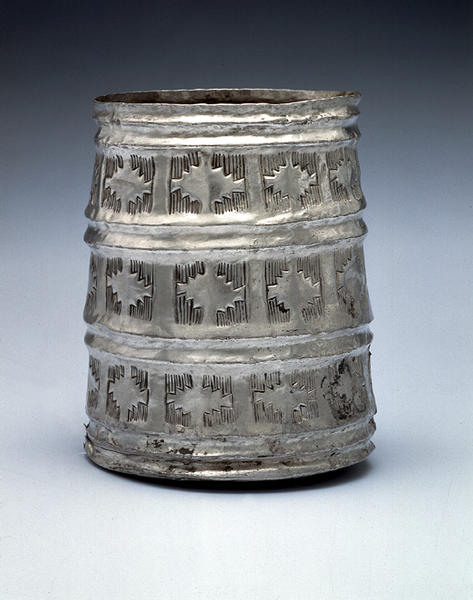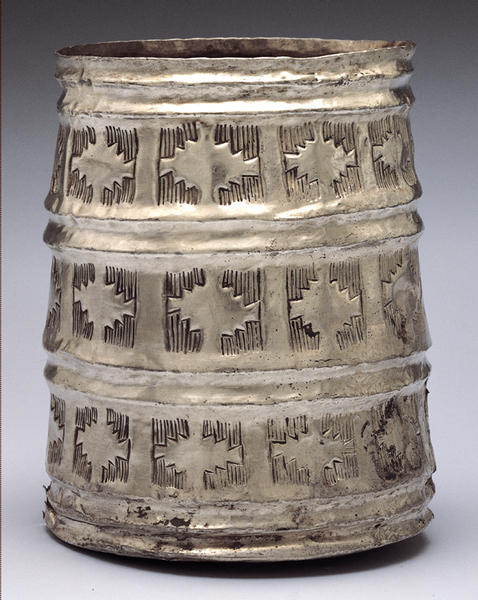鋸壁文円筒杯
- バクトリア地方
- 紀元前3千年紀後期-紀元前2千年紀初期
- 銀
- H-12.4 D-11.7
この容器に連続的に描かれている鋸壁文付十字形文様は、中央アジア西部の金石併用期(前4千年紀)に作られた彩文土器に最初に出現したモティーフである。十字形文も含めた階段状の文様は、「フッロル遺宝」の金製、銀製容器にみられる。また鋸壁文付十字形はバクトリアで作られた多数の金属製スタンプ印章にも表現されており、古代世界において多くの地域で製作された印章やその他の作品にみられるさまざまの形をした十字形文様と同様に、ある特定の意味をもっていたものと考えられる。
古代の文化圏
紀元前三千年紀頃から南イランにエラム王国が興り、このアフガニスタン、東イランの鉱石原料や加工品のメソポタミアへと至る交易を支配しました。
エラムはメソポタミア.シュメールと密接な影響関係があり、またイラン高原、更に中央アジアに至る広範な地域がその文化圏の後背地であったと考えることが出来ます。
・Pierre Amiet/ The Period of Irano-Mesopotamian Contacts/ in 'Early Mesopotamia and Iran: Contact and Conflict 3500-1600 BC' ed.J.Curtis London 1993
婦人座像
牡牛像形分銅
獅子文様壺
農耕饗宴図杯
ラピスラズリロード
古代中央アジアで産出したラピス・ラズリがエジプトの神像に使われていた事は、当時すでにオリエント世界に広範な交易が存在した事を示しています。
エジプトではすでに紀元前4000年紀後半(3,500~3,000 B.C.頃)には彼の地では産しないラピスラズリを使った宝飾品が出現していますが、少なくとも紀元前三千年紀には、東はインダスの河谷地域からメソポタミアを中継し、西はエジプトに至る、いわゆるラピス・ラズリ=ロードと呼ばれる交易路が存在したと考えられています。
・Horst Klengel/ Handel und Haendler im alten Orient/ 1983 Leipzig
(古代オリエント商人の世界 江上波夫、五味亨訳 山川出版社 1983)
婦人座像
牡牛像形分銅
獅子文様壺
農耕饗宴図杯
文様について
この杯は中央アジア、バクトリア地方由来と言われていますが、この幾何学文様はバクトリアから東イランにかけて見られる階段状十字文様で、焼き物や金属器上の文様、宝飾品の意匠などに広く適用されています。
同地域由来の円盤型の分銅にもこれが見られ、同地域の牛の図像と組み合わせたものもあります。
Catalogue Entry
This vessel is roughly cylindrical in form and has raised horizontal bands that protrude from the surface.1 The three registers of decoration are divided into rectangular panels, with ten in each row. Each of these panels contains a central crenellated cross surrounded by vertical hatching, alternating with plain narrow vertical bands. As the vessel is wider at the base, the crenellated crosses increase in size in the lower registers so that the rows of panels do not align from top to bottom. The vessel has a dropped circular base similar to that of the cup in catalogue number 17.
The crenellated-cross pattern repeated on this vessel is a motif that first appears on the painted pottery of western Central Asia in the Chalcolithic period (4th millennium B.C.).2 Stepped designs including cross patterns are found on gold and silver vessels from the "Fullol hoard."3 Crenellated crosses also occur on a large number of Bactrian metal stamp seals and, like the cross patterns, of various forms found on seals and other objects in many areas of the ancient world, may have had a specific meaning. A cross with stepped crenellations also seems to have been a significant motif in Iran, and is found on a Proto-Elamite wall painting from Tell Malyan as well as on an "intercultural style" carved chlorite vessel.4
JA
1. See Amiet 1986, pp. 201, 326, fig. 200.
2. See Masson 1988, pl. xvii.
3. See Maxwell-Hyslop 1982, p. 28, figs. 5-7.
4. See Amiet 1986, p. 262, fig. 52; Amiet 1988a, p. 365, fig. 11.
解説(古代バクトリア遺宝展)
前三千年紀後期―前二千年紀初期
銀
高12.4 cm 径11.7 cm
この円筒形の銀杯には、3段に分かれて、階段状の意匠の鋸壁文によって構成された十字形が10組ずつ刻まれている。この意匠は早くはカスピ海東部の南トルクメニスタン・ナマーズガ文化二期(前四千年紀)頃より土器の文様に現れ、前三千年紀にはオクサス川(アム・ダリア)とその支流域や東イランの諸地域に広がった。この意匠は土器だけではなく、宝飾品やスタンプ印章にも適応されたが、実際の建築に見られる銃眼構造とのつながりが指摘され、何らか邪気を祓うような意味合いが込められていたと考えられる。
Catalogue Entry(Bac#005)
Late 3rd‐early 2nd millennium B.C.
Silver
H. 12.4 cm, Dia. 11.7 cm
This cylindrical cup made of silver has been divided vertically into three bands, with each band made up of a crenellated pattern. These patterns create cross-shaped motifs and ten such groupings are found on this cup. This design first appeared in the eastern Caspian region in the Turkmenistan Namazga II culture (4th millennium BC) as a design on pottery, and this design then spread to the Oxus River (Amu Darya) and its tributaries, and various regions of eastern Iran during the 3rd millennium BC. This design then became suitable not only for pottery, but also for jewelry items and stamp seals. Connections with the actual crenellated structures have been indicated, and it is thought to hold some sort of exorcising of evil spirits meaning.

